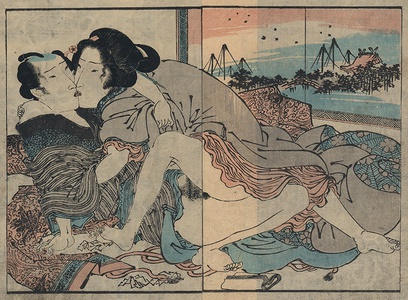| Method | Woodblock (nishiki-e) |
| Artist | Keisai Eisen (1790-1848) |
| Published | c. 1823 |
| Dimensions | Two Hanshibon sheets [each sheet ~222 x 155 mm] |
| Notes |
Series: (Keichū kibun) Makura bunko: Heard and Recorded in the Bedroom: Pillow Library A print from of Keisai Eisen's (Keichū kibun) Makura bunko: Heard and Recorded in the Bedroom: Pillow Library a sexual encyclopaedia issued in three parts each with two volumes in 1822, 1823, and 1824. This print is from Volume V and this from the two volumes produced in 1824. In this print man and a geisha kiss as they make love on top of phoenix patterned blanket, the woman's right hand wraps around the man's shoulders, her left hand is on his right arm and inside of his kimono sleeve, he leans back, used and new tissues lie in the foreground. The geisha's kimono has a flower and spider web pattern, apparently worn as a good luck charm so the customer would come back. The motif can also symbolise the grasping happiness, and as blossoms are caught in the web it could be grasping beauty and/or the momentary pleasure from love making or a combination of all of those things and a reference to the fact that geishas were not allowed to have their own lovers and were often unhappy. A screen behind with a landscape with mast, flying birds and bridge, an allusion to the man's virility being like the mast of a ship while also alluding to the Floating World, the Yoshiwara itself surrounded by water, the commercial sale of sex being the called the water trade, and to the female aspect of yin. Shunga is the term used for the body of erotic imagery produced in Japan from 1600 to 1900. The term shunga means spring pictures, a euphemism for sex, and is one of several names for erotic material produced in Japan. Shunga took different formats: painted hand scrolls, painted books, printed books and albums, and sets of prints which were sometimes sold in wrappers. As prints they are one of the genres of ukiyo-e, or Floating World prints, which also include fukeiga (landscape prints), and bijin-ga (prints of beautiful women). Most of the major ukiyo-e artists produced shunga material at some point during their careers, including Utamaro (who produced more erotic books than non-erotic books), Hokusai, and Hiroshige. Produced at the same time as the introduction of full colour woodblock printing, shunga prints and books were made using the most lavish and complicated printing techniques, including gauffrage, metallic inks, mica, complicated printed patterns, and multicolour printing using a high number of different colours. Although prolific in its number and variety, shunga should be seen as more representative of the ideals of the ukiyo, with its emphasis on mutual pleasure, rather than as an accurate representation of Japanese attitudes and practices of sexuality. Shunga present an invitation to pleasure through the bliss of lovemaking and though largely heteronormative, they portray the full gamut of couplings, married or otherwise, often surrounded by lavish settings and objects of pleasure. Keisai Eisen (1790 – 1848) was a ukiyo-e artist born in Hoshigaoka in Edo Japan. The son of the samurai, poet, and calligrapher Ikeda Masahei Shigeharu, Eisen studied painting in the Kanō style under Kanō Hakkeisai from whom he got the name Keisai. He then went on to train as a Kabuki playwright. After the death of his father, he lodged with the familyof Kikugawa Eizan. It was then that Eisen became interested in ukiyo-e and studied under Eiji, Eizan's father. It was also at this time that he became interested in the work of Hokusai who heavily influenced his style. Keisai Eisen (1790-1848) was a ukiyo-e artist born in Hoshigaoka in Edo Japan. The son of the samurai, poet, and calligrapher Ikeda Masahei Shigeharu, Eisen studied painting in the Kanō style under Kanō Hakkeisai from whom he got the name Keisai. He then went on to train as a kabuki playwright. After the death of his father, he lodged with the family of Kikugawa Eizan. It was then that Eisen became interested in ukiyo-e and studied under Eiji, Eizan's father. It was also at this time that he became interested in the work of Hokusai who heavily influenced his style. Eisen specialised in bijin-ga (pictures of beautiful women), including his o-kubi-e (large head pictures) and full length portraits, also made landscapes and pictures of famous places contributing 24 designs to Kisokaidō rokujūkyū-tsugi: Sixty-nine Stations of the Kisokaidō Road, c. late 1830s) designed with Hiroshige. He designed many erotic prints and book illustration as well as compiling medical texts and sex manuals into the four volume (Keichu kibun) Makura bunko: Heard and Recorded in the Bedroom: Pillow Library. In addition to prints, painting, and book illustrations Eisen also wrote novels, plays, history books, legends and biographies notably the second edition of Ukiyo-e Ruiko (History of Prints of the Floating World) which contains the most comprehensive collection of biographies of ukiyo-e artists including himself in which he describes himself as a heavy drinker and claimed to have owned a brothel in Nazu in the 1830s. Ex. Col: Peter Darach Reference: International Research Centre for Japanese Studies, Ehon (Uliyo-e Shunga) Database, Serial Number 37. Clark, Timothy. Shunga: Sex and Pleasure in Japanese Art. The British Museum, 2013, pg. 355, 103. Condition: Some rubbing and light soiling to lower left and right corners. |
| Framing | unmounted |
| Price | £150.00 |
| Stock ID | 53169 |

